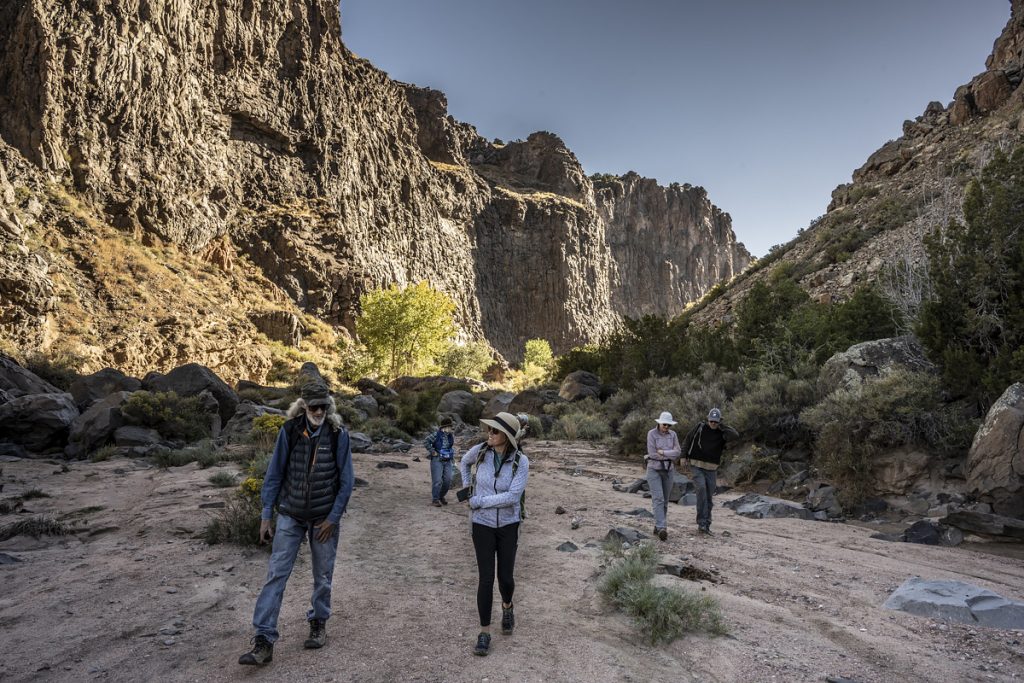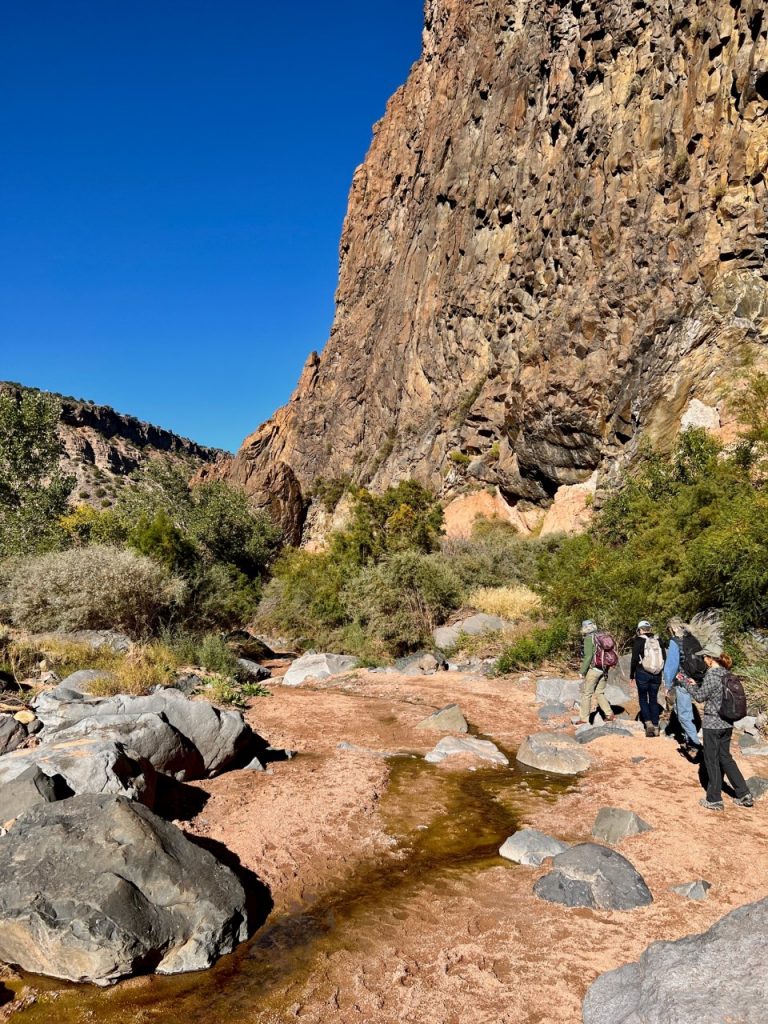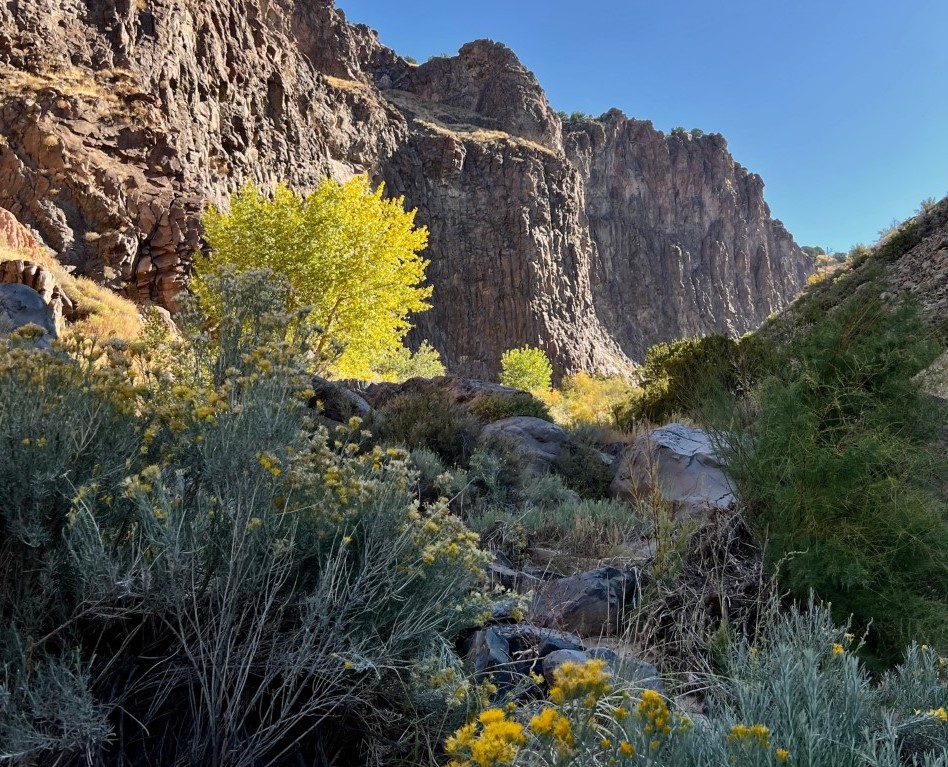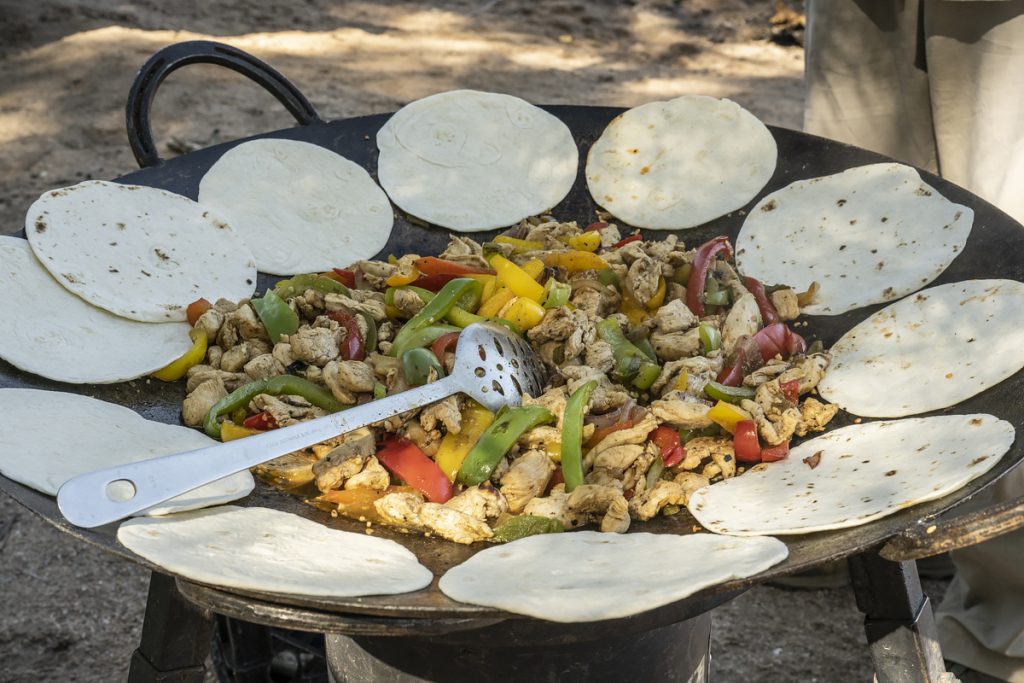By Sara Bergthold, NM Wild’s Digital Communications Coordinator

In mid-October, several members of the Aldo Leopold Circle joined New Mexico Wild staffers on a hike through Diablo Canyon in the northernmost section of the Caja del Rio Plateau. Despite being someone who has spent much of her life living and recreating in the Rio Grande Valley, this was my first visit to the Caja del Rio. Approaching the day with fresh eyes, I was eager to discover what this heralded landscape was all about.
I received a glimpse of what was to come as we drove down the dirt road into the Caja del Rio. The scattered houses lining Camino la Tierra eventually petered out, allowing a clear view of distant pinion-covered peaks and rocky outcroppings dotting the horizon. Cows sauntered about kicking up dust in the morning light, and several structures, which I’d later learn were part of the City of Santa Fe’s municipal well infrastructure, peeked out from behind passing brush and hills.
The Diablo Canyon recreation area is located about forty minutes from Santa Fe and an hour and a half from Albuquerque. About 15 folks convened on a crisp, early Fall morning in the parking lot. As the group slowly grew with arrivals, New Mexico Wild’s Northern Conservation Director, Garrett VeneKlasen, introduced the area and gave us a rundown of the issues the Caja del Rio faces.

From off-road vehicles damaging the fragile landscape to make-shift shooting ranges that pose a nuisance and danger to others recreating in the area, the challenges the Caja del Rio faces are nuanced and complex. But it’s clear that at the base of these issues lies a mutually shared love of this landscape and a singular need to protect it in a way that allows folks from all backgrounds, cultures, and walks of life the opportunity to enjoy this treasured and storied land for years to come.
Attending high school in Albuquerque in the early 2000s, I often heard tales about wild parties held overnight in Diablo Canyon. This morning, there was no sign of riffraff in the quiet canyon aside from a small film crew preparing to shoot what they described as a “post-apocalyptic war movie.” After being courteously warned by the Director that we may see men carrying plastic guns, our group of hikers made its way into the mouth of Diablo Canyon.

Caja del Rio translates to “River Box,” an homage to this canyon and several other box canyons that help define this landscape. And it’s true, Diablo Canyon wasted no time in showing off its finest box canyon features: towering, cracked basalt walls surrounded us almost immediately, their dark surface reflecting the morning sun. We followed a slight trickle of water through the most dramatic frame of the canyon, periodically stopping to admire the view by looking up, mouths agape, at the sheer walls around us. A hazy golden light wrapped through the canyon and a young cottonwood’s leaves were turning a soft yellow almost before our eyes. The delicate beauty surprised even the most seasoned hikers among us.

As we continued, the spring petered out and the cliffs gave way to a deeply cut ravine walled 15 feet high on one side by dirt. The group marveled at a recent bank collapse, where boulders the size of bowling balls now lay piled on the dry riverbed. Later, a few of us spotted a lone tarantula meandering across the riverbed in search of a mate. We took turns pulling off layers of clothing as the sun warmed the landscape. The group naturally dispersed into smaller pairs, chatting, stopping for photographs, and enjoying a meandering walk toward the mighty Rio Grande.

After about two and a half miles of walking, the Rio Grande bosque slowly materialized ahead of us and I could hear murmurs of gratitude from my fellow hikers. The approach to the river felt hard-earned after trudging through the soft sand of the dry riverbed. Standing on the bank, I admired the first touch of fall on the cottonwoods across the water. After snapping a few photos and appreciating a narrow leaf cottonwood seldom seen in this area, we found the rest of our party, who had driven ahead to set up for lunch in the shade of the cottonwoods.


We had certainly worked up an appetite, so it was a delight to find that the preparation for a hot lunch of chicken fajitas was underway. There was even a vegetarian option for folks who didn’t want chicken. Garrett brought his discada to cook on, which is a propane cooker originating in agricultural communities in Northern Mexico. Wok-like, traditional discadas are often constructed from agricultural parts like a plow disc harrow and horseshoes for handles. After heaping piles of onions, bell peppers, and chicken onto the discada, a jar of traditional New Mexico red Chile was cracked open and poured all over the steaming concoction. It may be that I was particularly hungry on this day, but this was one of the most delicious fajitas I’ve had in recent memory, and it was an especially unique pleasure to enjoy a meal in fresh air, on the banks of a high-flowing Rio Grande.

With full bellies, we dismantled our lunch station, also packing out a couple of additional bags of trash that our team had collected upon arrival at the lunch spot. This section of the Caja del Rio is particularly accessible and therefore sees a high volume of year-round use. Unfortunately, this seems to have led to a buildup of garbage left over by folks who do not abide by the most basic tenets of Leave No Trace ethics.
We walked back to the trailhead under a blazing hot afternoon sun, appreciating that this hike would be almost unimaginable in the heat of summer! A red-tailed hawk circled low overhead and I watched a thirsty-looking dragonfly land for a brief rest on the hot sand before continuing its journey. Passing through Diablo Canyon as the late afternoon sun bounced behind the canyon walls, I felt full and grateful for the day.

Spread across 104,000 acres, the Caja del Rio plateau pulses with life far beyond the tiny sliver I visited today. From the hundreds of species of wildlife that call the Caja del Rio home, to the volcanic features, vibrant river corridor, and innumerable cultural areas of significance, I find it difficult to imagine the vastness of this landscape and all it holds. I feel a wild appreciation for the opportunity to visit and discover such a rich and complex landscape this close to home.
The Caja del Rio is timeless, but to me, the discovery of this hidden treasure holds a newness and a special type of thrill. On my car ride back to Albuquerque, I imagined the hikes I might take, the afternoons winding lazily along the river, and the ancestral sites that will captivate me on future visits to the Caja. I hope to see this landscape protected, valued, and respected so that I, and many others, can continue to discover the enchantment held within the Caja del Rio.
Click here to learn more about why the Caja del Rio is one of our protection priorities.

